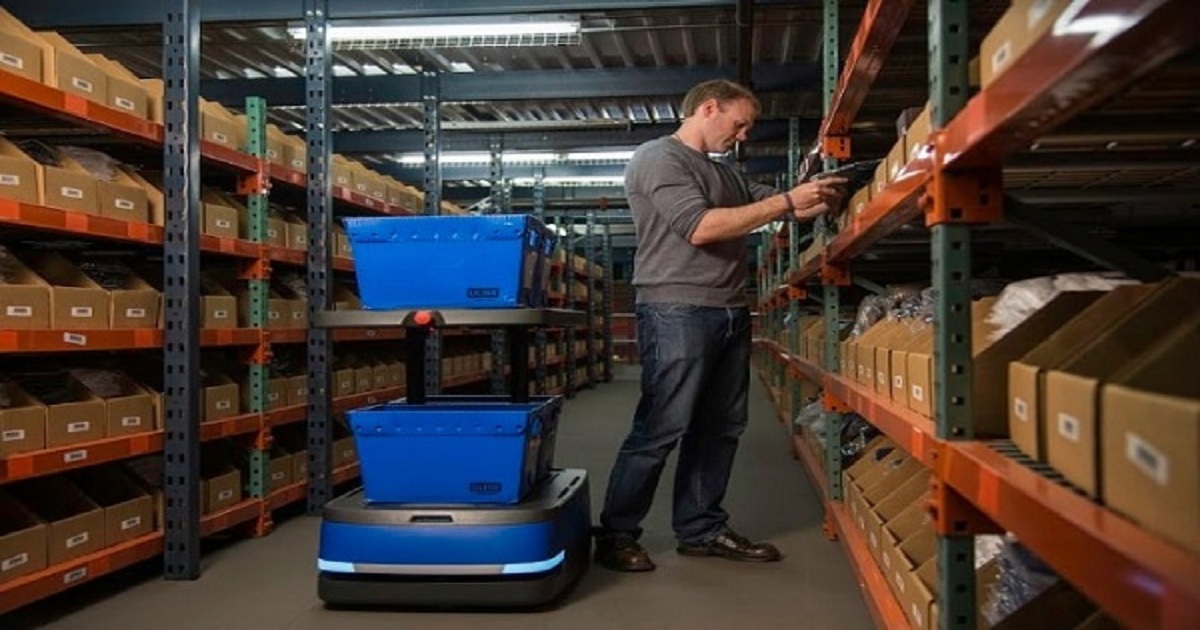
Warehousing and Distribution
Article | June 27, 2023
Order picking is the most resource-intensive operation of a warehouse or fulfillment center. More than 55% of the operating cost for a warehouse is related to order picking, and fulfillment centers, the number stands at 50%. It is the process that can bring in the most cost savings with an effective, streamlined and efficient order picking system. One of the most important components of your order picking system is the warehouse order picking cart. Order picking carts are used to move inventory from the warehouse shelves to sorting or packing stations. They make it easier for warehouse associates to carry multiple items at a time or to carry large, unwieldy items. When it is possible to carry multiple items on a trip, it drastically reduces the distance traveled by associates on foot. It also helps to reduce physical fatigue and improves efficiency dramatically.
Read More

Warehousing and Distribution
Article | July 11, 2023
Efficiency is crucial for B2B supply chain success. Effective supply chain management techniques can streamline operations, reduce costs, and enhance customer satisfaction from planning to delivery.
Contents
1. Strategic Planning to Enhance Supply Chain Optimization
1.1 Roadmap for Developing Supply Chain Optimization
1.2 Integrating Supply Chain Strategy with Business Strategy for ROI Growth
2. Effective Procurement Strategies to Maximise ROI in Supply Chain
2.1 Supplier Relationship Management
2.2 Cost-effective Procurement Processes
2.3 Continuous Improvement and Innovation
2.4 Risk Management and Mitigation
3. Optimizing Supply Chain with Effective Demand Forecasting Techniques
3.1 Anticipate Future Demand
3.2 Overstocking and Understocking Risk Management
3.3 Integrated Forecasting approach between Supply Chain Stakeholders
4. Emerging Technologies for Supply Chain Optimization Leveraged by Enterprises
4.1 AI and ML
4.2 Blockchain Technology
4.3 IoT
4.4 Augmented Reality and Virtual Reality
5. Leading Solution Providers for B2B
6. Conclusion
Optimizing the B2B logistics and supply chain management has become a crucial business strategy to increase efficiency, cut costs, and boost customer satisfaction in the fiercely competitive business environment. With the increasing customer demand, supply chain managers now emphasize on faster, more precise, and unique ways to fulfill orders with enhanced logistics management techniques.
“Companies that optimize their supply chain operations experience a 2.3 times greater EBITDA (earnings before interest, taxes, depreciation, and amortization) than their competitors.”
(Source - A survey by Deloitte in 2020)
Despite the significance of supply chain optimization, it is challenging to keep up with the latest industry trends and best practices due to the dynamic nature of the logistics industry. Learning the value of optimizing the B2B supply chain and how it can assist businesses in keeping up with the ever-growing demands of their customers through planning, strategizing and leveraging technologies helps businesses maintain a competitive advantage and achieve sustainable growth.
1. Strategic Planning to Enhance Supply Chain Optimization
To achieve optimal results, businesses must develop a comprehensive plan outlining their supply chain improvement goals, objectives, and strategies.
1.1 Roadmap for Developing Supply Chain Optimization
Developing a roadmap for supply chain optimization includes reviewing current operations that help in identifying the strengths and weakness of the supply chain management and assist in recognizing the opportunities for improvement, establishing SMART goals and objectives, defining strategies to meet these goals, involve streamlining processes, investing in technology, improving supplier relationships, and engaging customers and actions, as well as ensuring market adaptability to accommodate changing market conditions and evolving customer needs through assessment and adjusting the roadmap.
1.2 Integrating Supply Chain Strategy with Business Strategy for ROI Growth
Integration of the supply chain involves aligning the supply chain objectives with the overall business goals, such as revenue growth, cost reduction, and customer satisfaction. The integration ensures the supply chain operations support the business goals, like cost reduction, customer satisfaction and revenue growth.
"Companies that successfully integrate their supply chain and business strategies can reduce operating costs by 10-15% and increase efficiency by 20-30%.”
(Source - A study by Accenture in 2020)
The alignment further helps track KPIs and data-driven decision-making and continuously improves the supply chain operations to achieve objectives. Furthermore, it assists in better planning, coordination, and execution of supply chain activities, resulting in faster and more accurate fulfillment of customer orders.
2. Effective Procurement Strategies to Maximize ROI in Supply Chain
Procurement strategies can raise productivity in the fast-paced logistics management and supply chain industry by optimizing the supply chain, boosting efficiency, and giving a competitive edge.
2.1 Supplier Relationship Management
Effective supplier relationship management (SRM) can result in more competitive pricing, enhanced product quality, and increased dependability. To accomplish SRM, businesses must identify key suppliers, develop partnerships, communicate effectively to ensure clear expectations and mutual understanding, share information and collaborate to foster innovation and continuous improvement.
2.2 Cost-effective Procurement Processes
Implementing cost-effective procurement procedures can help businesses reduce expenses and enhance productivity. To achieve cost-effectiveness, businesses should streamline operations to save time and money, leverage technology to automate processes and improve accuracy and negotiate with suppliers for better pricing and terms.
2.3 Continuous Improvement and Innovation
Continuous improvement and innovation are necessary for logistics and the supply chain to remain competitive. This involves regularly reviewing and updating procurement processes, supporting supplier innovation, and keeping up with procurement and supply chain management technology trends and developments.
2.4 Risk Management and Mitigation
Effective risk management and mitigation strategies are essential to prevent disruptions in the supply chain. To achieve this, businesses should focus on identifying potential risks and developing mitigation strategies, incorporating redundancy into the supply chain to minimize the impact of disruptions, and establishing transparent emergency communication and escalation procedures.
3. Optimizing Supply Chain with Effective Demand Forecasting Techniques
3.1 Anticipate Future Demand
Accurate demand forecasting is crucial for supply chain optimizing done by analyzing real-time supply chain data to identify trends. For demand forecasting, businesses can utilize historical sales data, market trends, and customer feedback. To make accurate forecasts, companies must consider various factors influencing demand, such as seasonality, economic conditions, and shifting customer preferences.
3.2 Overstocking and Understocking Risk Management
Demand forecasting errors can lead to overstocking and understocking in supply chain management. Using demand forecasting rightly can determine the optimal inventory level at any given time to avoid overstocking and understocking. Businesses can predict demand and adjust inventory by analyzing sales data, market trends, and other factors.
3.3 Integrated Forecasting approach between Supply Chain Stakeholders
The integrated forecasting approach entails coordinating data sharing and communication between all supply chain stakeholders, from suppliers to customers. Stakeholder participation in demand forecasting improves accuracy. In addition, each stakeholder has unique knowledge and perspective that can help identify trends and patterns.
4. Emerging Technologies for Supply Chain Optimization Leveraged by Enterprises
4.1 AI and ML
Leading SCM providers do offer regression modeling and causal analysis for demand forecasting. Using AI and ML, the functionality is embedded within the DP module. If a more rigorous and sophisticated approach is desired, it is possible to forecast demand numbers outside the SCM system using sophisticated modeling and then upload them back into the SCM system.
4.2 Blockchain Technology
Blockchain enables secure, transparent, and decentralized transactions. It can be utilized in the supply chain to track the movement of goods, reduce the risk of fraud, and increase supply chain visibility by maintaining an immutable record of every transaction.
4.3 IoT
To monitor humidity, temperature control, and other environmental factors that affect the quality of products while in transit. IoT helps businesses enhance supply chain visibility, reduce product spoilage risk, and enhance customer satisfaction using modern temperature control technology.
4.4 Augmented Reality and Virtual Reality
AR and VR technologies are transforming the supply chain by improving the accuracy of inventory management, reducing errors, and enhancing the training of employees. In addition, its tools can be used to create digital representations of warehouses, products, and equipment, allowing employees to visualize the supply chain and identify areas for improvement.
5. Leading Solution Providers for B2B
Several leading B2B companies have been identified based on research for supply chain optimization. To optimize supply chains, these companies have demonstrated a commitment to strategic planning, effective procurement strategies, and demand forecasting techniques. The solution providers also recognize the significance of managing risks associated with overstocking and understocking and have implemented integrated forecasting approaches with their supply chain partners and customers. In addition, these companies use emerging technologies such as augmented reality, virtual reality, cloud technology, machine learning and AI, blockchain technology, and the IoT to improve their supply chain operations. By prioritizing supply chain optimization, the following B2B companies gain a competitive advantage within logistics and supply chain industries and provide exceptional customer experiences.
Coupa Software
The supply management solutions offered by Coupa Software are hosted in the cloud and make use of machine learning and artificial intelligence to provide businesses with insights that can be used for data-driven decision-making.It assists businesses in tracking the performance of their supply chains compared to key performance indicators, identifying areas in which advancements can be made, and taking action to optimize their supply chain operations.
Stord
Stord a platform provider, offers a suite of software solutions that improve supply chain management for businesses. Its warehousing, transport, and inventory management solutions are integrated into a single platform. As a result, Stord offers companies greater visibility and control over their supply chains, allowing them to make more informed decisions and optimize operations by combining these functions into a single platform.
Roambee
Roambee is an artificial intelligence (AI)-powered platform that provides improved supply chain and visibility solutions for real-time, on-demand, and end-to-end data. Using cloud data analytics and automation, it assists in monitoring shipments, inventories, and returnable assets to provide dependable and responsive monitoring solutions. The result is a return on investment (ROI) of 4X or more on the supply chain assets by optimizing inventory levels and utilization.
FlowSpace
FlowSpace offers cloud-based supply chain solutions. With an internet connection, businesses can access real-time inventory, orders, and shipments from anywhere. Its solutions optimize inventory and demand fulfillment with machine learning and predictive analytics. In addition, IoT sensors and beacons provide accurate warehouse operations data for the company. FlowSpace uses cutting-edge technology to provide efficient and effective supply chain solutions.
OPTEL Group
OPTEL Group's cutting-edge traceability solutions help businesses optimize their supply chain. These solutions permit businesses to track their products and materials throughout the supply chain, from production to distribution. It's traceability solutions provide businesses with real-time visibility into their supply chain operations by utilizing advanced data capture technologies such as barcode scanning, RFID, and serialization. This allows them to identify potential bottlenecks, optimize workflows, and decrease waste and inefficiency.
Blue Ridge
Blue Ridge,a provider of cloud-based supply chain solutions, has developed a suite of solutions that make use of machine learning and artificial intelligence to improve the accuracy of forecasts, reduce the costs associated with inventory, and increase company's profitability. It does this by providing businesses with flexible and scalable solutions, as well as ones that can be adapted to meet the particular requirements of each business.
GMDH Streamline
GMDH Streamline makes use of complex algorithms to perform data analysis and provide insights that, when implemented in B2B logistics operations, can lead to increased efficiency and a reduction in costs. This software can analyze past sales data and make predictions about future demand patterns, which helps to ensure that the right products are always available for purchase. Because of this, there will be less of a need for excessive stockpiling, which can prevent the free flow of capital and raise the risk of stock obsolescence.
Netstock
Netstock's cloud-based solutions provide businesses the agility and responsiveness they need to stay competitive in the ever-changing business landscape. With its seamless integration with industry-leading ERPs, Netstock unlocks valuable ERP data and enables businesses to make informed decisions based on enhanced analytics. In addition, by leveraging Netstock's solutions, businesses can respond swiftly to supply and demand fluctuations, resulting in optimized logistics and efficient supply chain management.
Solvoyo
With Solvoyo's platform, businesses can optimize their supply chain performance, reduce inefficiencies, and achieve cost savings. In addition, the platform offers advanced scenario modeling and real-time analytics to help companies to make informed decisions and quickly adapt to changing market conditions. By leveraging Solvoyo's capabilities, businesses can achieve a competitive advantage and drive growth in the dynamic world of supply chain management.
American Software, Inc.
American Software provides logistics and supply chain companies with supply chain management software solutions. Its solutions including supply chain planning, warehouse management, transportation management, global trade management, and vendor inventory management are intended to assist businesses in optimizing their B2B logistics operations, increasing their efficiency, and lowering their expenses. In addition, it provides modern temperature control technology to ensure safe and efficient transport of temperature-sensitive goods in the supply chain.
6. Conclusion
“The global supply chain management market size is expected to reach USD 37.4 billion at a CAGR of 11.3% by 2027."
(Source - Grand View Research)
The anticipated growth of the global supply chain management market presents businesses with opportunities to enhance their supply chain operations by implementing innovative technologies and strategies. The increase in market size indicates a growing demand for efficient supply chain management solutions that reduce costs, optimize efficiency, and improve customer satisfaction. Businesses can use AI, blockchain, and augmented reality to analyze real-time data, forecast demand, and streamline procurement. These technologies and strategies can give logistics and supply chain management businesses an edge in the increasingly competitive marketplace.
Read More

Warehousing and Distribution
Article | July 11, 2023
The complex, hyper-connected nature of global supply chains makes them extremely vulnerable to a range of risk factors. In 2019, corporations experienced new levels of volatility in commodity and energy pricing, interest and exchange rates, and general international trading conditions. In 2020, things are likely to remain rocky. Research shows that many businesses, despite being forewarned about these risks, are still tending to be reactive rather than proactive in their approach.
Read More

Warehousing and Distribution
Article | July 11, 2023
Transform the supply chain with cutting-edge warehouse automation tools. Enhance productivity, minimize costs, and deliver exceptional customer experiences to stay ahead in the competitive market.
In the rapidly evolving world of manufacturing, logistics, and supply chain management, adopting automation has become imperative for businesses aiming to maintain a competitive edge. By minimizing costs, enhancing efficiency, and reducing downtime, automation delivers optimal value for manufacturers. However, selecting the right partner can be challenging with numerous warehouse automation companies available. This article explains the features and benefits of top ten warehouse automation tools that offer expertise in improving business operations. These data warehouse tools provide comprehensive solutions to meet diverse needs of the logistics and warehousing companies and improve the supply chain performance.
1. 3PL WMS Software Solution
3PL WMS Software Solution is one of the leading warehouse automation tools for supply chain operations. This software has comprehensive features that automate and streamline warehouse processes, offering unprecedented efficiency. The tool seamlessly integrates with existing systems and provides total transparency and control. 3PL warehouse automation software boosts order throughput, reduces pick time, and automates billing effortlessly. Gain unprecedented insights through accurate, real-time reporting, ensuring inventory accuracy and reducing lost-inventory costs. This warehouse automation tool, designed as the warehouse management backbone, revolutionizes operations, enhances customer satisfaction, and drives exponential growth.
2. Datex 3PL WMS
Datex 3PL WMS offers the most innovative warehouse management tools that help implement warehouse automation in the supply chain process for transportation services. This software empowers transportation and logistics services, revolutionizing material handling, storage, trans-loading, cross-docking, and more. It supports diverse industries such as refineries, steel mills, and energy distribution facilities. Its flexibility makes it an optimal solution to handle any inventory type, including bulk materials, steel products, liquids, and hazardous materials. This automated warehouse software also enables multi-warehouse operations and accommodates various modes of transportation. Additionally, Datex 3PL WMS boasts a highly flexible billing system, allowing individualized billing strategies and capturing value-added services. Industry experts benefit from streamlined processes, improved efficiency, and accurate billing, ultimately enhancing their supply chain business and warehouse operations.
3. Deposco
Deposco Bright Warehouse is a game-changing warehouse management software solution that offers advanced features and capabilities to businesses of all sizes. This data warehouse tool empowers companies to pick, pack, and ship orders efficiently, optimizing processes to further improve order fulfillment while reducing operational costs. It provides strategic order allocation, workgroup segmentation, and optimized picking strategies, to achieve accurate and speedy order fulfillment. The software offers network-wide inventory visibility through advanced tracking, barcoding, and management capabilities. This solution automates shipping processes by seamlessly integrating with carriers, ensuring maximum accuracy and speed. Leveraging its material handling technology for automation can lead to significant productivity improvements. Businesses can enhance their capabilities by accessing a unified view of operations, utilizing customization options, and benefiting from direct API integration with shipping carriers.
4. Softeon
Softeon is a powerful warehouse management tools for supply chain automation. Its comprehensive WMS optimizes distribution operations, handling all essential tasks while offering unique functionality for a competitive edge. With a proven deployment success rate and flexible delivery options in the cloud or on-premise, Softeon empowers businesses to streamline inventory management and delivery processes. By integrating with their Warehouse Execution System (WES), warehouse and distribution companies can further enhance order fulfillment orchestration and optimization. Industry leaders like UPS Supply Chain Solutions and Sears Home Services rely on this warehouse automation software.
5. Logiwa WMS
Logiwa WMS offers a cloud fulfillment platform that combines WMS software and order fulfillment capabilities, enabling companies to operate a digital fulfillment network and expand their direct-to-consumer operations without the need for additional staff. The data warehouse management tool offers comprehensive warehouse and inventory management functionality, billing, and seamless integrations with over 200 ecommerce, accounting, and shipping solutions; it empowers 3PL providers to optimize order fulfillment, enhance speed and accuracy, and drive customer satisfaction.
6. SnapFulfill
SnapFulfill is one of the leading warehouse management technologies that empower companies across various industries, including B2C and B2B retail, third-party logistics, manufacturing, food and beverage, and electronics, to optimize their inventory, space, and resources. With SnapFulfill's class-leading warehouse management solutions, businesses can streamline operations and enhance efficiency. The software offers flexible deployment options and payment methods for diverse warehousing challenges. By utilizing SnapFulfill, industry experts gain access to advanced data warehouse tools that enable them to improve their supply chain business, enhance warehouse and distribution processes, and achieve optimal inventory management for increased productivity and profitability.
7. Indigo Software
Indigo WMS is an award-winning warehouse management system tool designed to enhance supply chain operations. It offers real-time control, visibility, and functionality for all warehouse processes. It is one of the best supply chain tools to track inventory in real-time, enabling efficient cycle counting, forward pick replenishment, and improved inventory forecasting. With Indigo WMS warehouse automation software, these tasks are automated, and the software ensures greater picking accuracy, reduces returns, and enables on-time and complete deliveries. It seamlessly integrates with existing systems, whether from SAP, Microsoft, Oracle, Infor, Sage, or other ERP, TMS, or SCP vendors, providing live and up-to-date data visibility across the entire supply chain process.
8. OrderWise
OrderWise is an order management system that empowers businesses in the consumer goods and retail sector to accelerate operations and deliver exceptional customer service. With its integrated features, OrderWise ensures seamless order processing and maximizes sales opportunities. By tracking orders from various sales channels, managing tight schedules, and making real-time adjustments, businesses can meet customer demands promptly. This is one of those supply chain management tools that provides valuable insights into customer purchase history and stock availability, enabling personalized recommendations and enhancing sales effectiveness. Whether for ecommerce, retail, or B2B sales, OrderWise streamlines order operations, making them smoother, faster, and more accurate.
9. Balloon One
Balloon One provides supply chain management tools, offering tailored software solutions to distribution, manufacturing, and e-commerce businesses. Its expertise lies in streamlining processes, optimizing resource allocation, and enhancing operational efficiency. With a focus on minimal disruption, Balloon One seamlessly implements software solutions, ensuring uninterrupted business operations. As an impartial advisor, the software offers both SAP Business One and NetSuite, thus allowing to recommend the ideal ERP system for each company's unique requirements. In addition, this software provides wholesale and distribution businesses with the robust HighJump WMS, a real-time warehouse management system that delivers scalability and flexibility.
10. Foxfire
Foxfire offers supply chain management tools specializing in Warehouse Management Systems (WMS). It offers WMS solutions, including features to optimize inventory, increase labor productivity, and enhance customer satisfaction. With over 20 years of industry experience, Foxfire has a proven track record of delivering measurable results to customers worldwide. This tool provides a comprehensive approach, including needs assessment, best practice recommendations, training, and ongoing support. Additionally, it is cost-effective by delivering low lifetime costs.
Conclusion
The warehouse automation market is experiencing significant growth, with a wide array of exceptional warehouse automation tools that offer high-quality solutions. Regardless of any special requirements, exploring the features of each warehouse automation tools is vital to identify the ideal fit for any business. Choosing the correct solution from the data warehouse tools list will help to improve inventory management and distribution efficiency through warehouse automation. Embrace the opportunity to streamline processes by leveraging supply chain management tools and warehouse automation solutions and experience the transformative power of automation to unlock the full potential of your business.
Read More